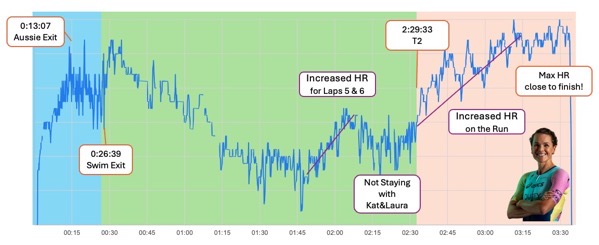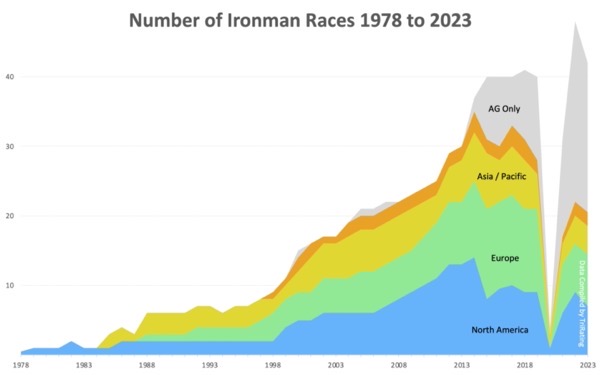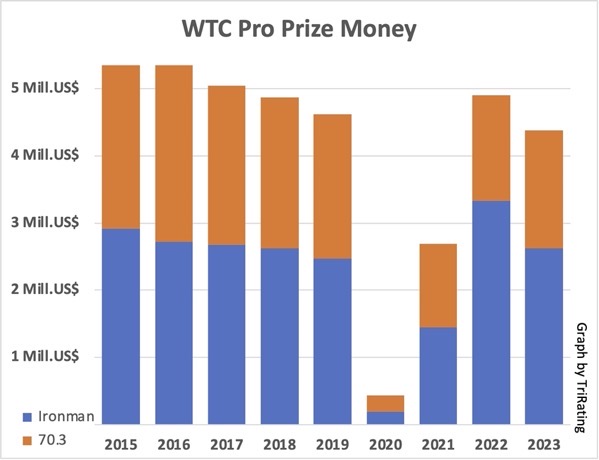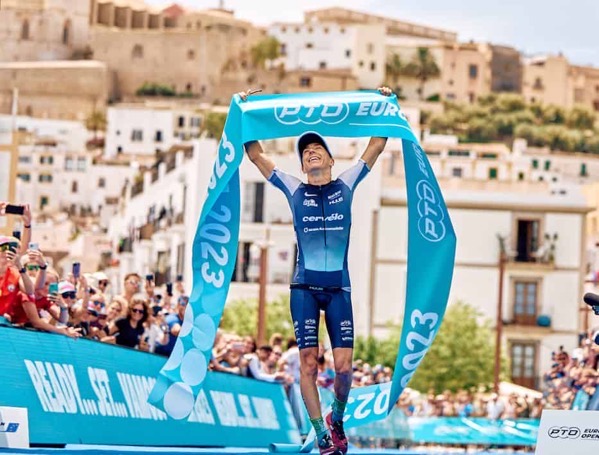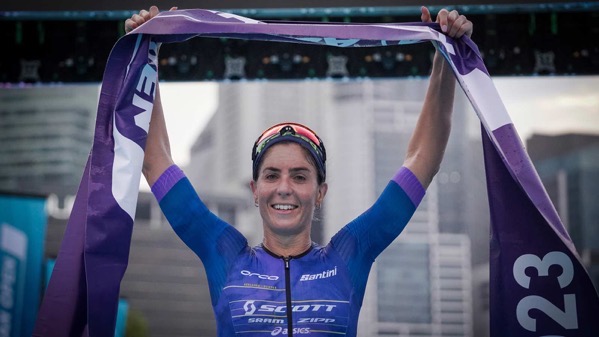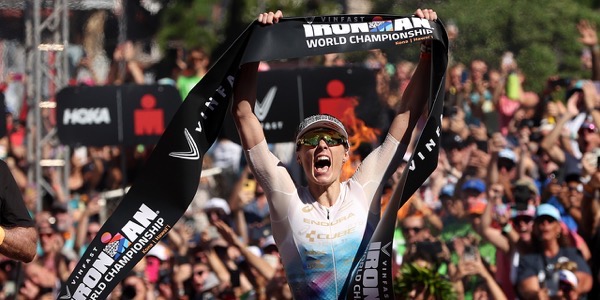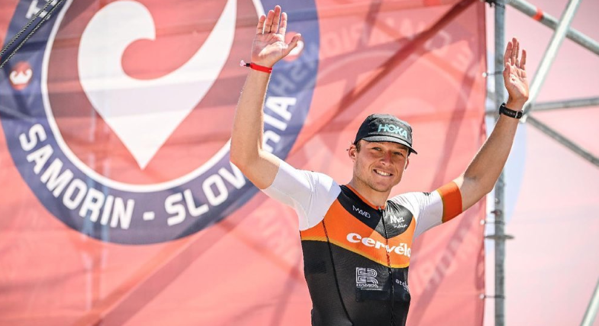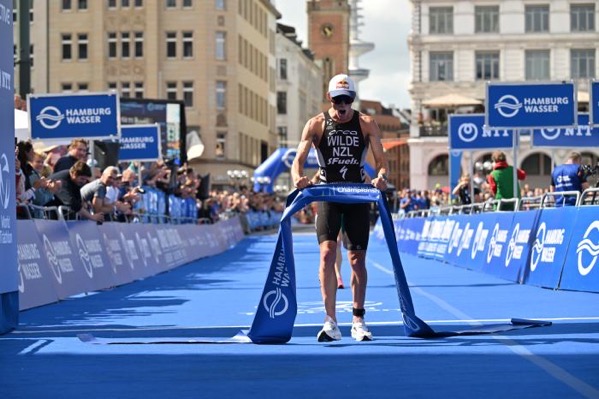With the addition of the T100 Series and the Ironman Pro Series, this year has seen big changes in Pro racing. Let’s find out how this has impacted the bottom line of the Professional athletes.
If you want to check out last year’s analysis, you can find it in my post “Deep Dive Into 2023 Triathlon Money List“.
Money List – Overview
First, here is an overview of the races that are included in the money lists and comparisons between the 2024 and 2023 seasons. The totals are shown in US$, for races that paid their prize purse in a different currency the amounts have been converted into US$.
| Type |
Description |
Total Money 2024 |
Change to 2023 |
Total Money
2023 |
# Pro Events
2024 (2023) |
| Ironman |
Ironman-branded races
+ 70.3-branded races
+ Ironman Pro Series |
$ 2.479.450
$ 1.786.700
$ 1.700.000 |
– 6%
+ 2%
new |
$ 2.624.400
$ 1.758.000
new |
21 (25)
38 (45)
new |
| PTO |
T100 races (incl. T100 Series Pool,
but contract payments not included §)
+ PTO Rankings Bonus |
$ 3.735.000
$ 2.000.000 |
+ 111%
+/- 0 |
$ 1.769.500
$ 2.000.000 |
7 (3)
1 (1) |
| Challenge |
Challenge-branded races (incl. Bonus Pool) |
$ 927.876 |
– 1% |
$ 934.408 |
28 (30) |
| WTS |
World Triathlon Series (incl. Bonus Pool) |
$ 1.731.800 |
– 6% |
$ 1.840.000 |
6 (9) |
| SuperTr |
SuperTri Professional Events
(incl. Series and Team Pools) |
$ 1.335.003 |
+ 16% * |
$ 1.150.000 |
5 (4) |
| Other |
Independent Races (e.g Embrun,
XTerra World Championships, Alpe D’Huez) |
$ 794.195 |
+11% |
$ 716.890 |
26 (26) |
| Total |
|
$ 16.490.024 |
+ 29% |
$ 12.793.198 |
132 (145) |
Two, somewhat technical annotations to the numbers in this table:
- § (to T100 money): There was a significant additional sum of money awarded for T100 contracts, at the start of the year it was announced to be $ 3 Million. However, there is no officially announced distribution of this amount to specific athletes, also some athletes returned their contracts and others might have been swapped in. Therefore, I have decided not to include this money in the prize money list (both in the categories reported above and in the individual earnings discussed below), but of course this is additional money that has been paid out to professional athletes.
- * (to SuperTri): In 2024, SuperTri has paid out the majority of their prize money to teams who then distributed this money to their athletes. I have assumed an equal split to the team’s athletes which is a reasonable starting point but could be different from what they have actually received. For 2023, team money was a smaller part of the overall SuperTri prize purse, and I have added the $300,000 to the number I had reported last year.
Some more detailed observations:
- As already mentioned, this year’s “headline features” were the introduction of the Ironman Pro Series and the PTO’s T100 Triathlon World Tour. I’ll refrain from a discussion as to which came first and which one was a reaction to the other, but these two have created a significant addition of prize money into long-distance triathlon. The Ironman Pro Series had a $ 1.7 M prize purse for the final Standings, the T100 Tour added new events and $2M prize money. (As mentioned above, the PTO also paid out roughly $3M to contract athletes for T100).
- Ironman prize money (without the new Pro Series Money) is slightly down compared to 2023, money for 70.3s is very slightly up. The prize money for the Pro Series did not come from reducing regular prize money for their events. However, the number of Pro races has gone down, from a total of 70 events in 2023 to 59 in 2024. Correspondingly, the number of athletes who have made money from Ironman has also gone down: In 2024 it were 432 different athletes after 524 last year.
- After a “gap year” of reduced events and prize money in 2023, the PTO have upped their game with the introduction of the T100 Tour. They increased their number of events from 3 in 2023 to 7 this year and continued to pay the PTO Rankings Bonus. With their additional payment of contract money for T100 athletes, they are now clearly the biggest player in term of prize money in Pro triathlon.
- In 2024, Challenge have consolidated their race calendar and paid out almost the same prize money as in 2023.
- WTS numbers are slightly down after they had to cancel or re-assign a few events.
- SuperLeague has become SuperTri in 2024. They’ve had one additional event and changed the way they pay out their prize money (see the *-annotation above), resulting in a slightly bigger overall prize purse.
- The number of independent races that are included has stabilized at a high level. Most of these are smaller events that are just above the minimum 10k US$ to be included in the PTO World Rankings.
Overall Money List
Kat Matthews is the overall leader of the 2024 Triathlon Money List, earning just shy of 550.000 US$ – the best earning season of any of the years I have looked at. With the additional money from T100 and the Ironman Pro Series, the number of athletes making more than $100.000 has also jumped up: Last year it was 29 athletes, this year 41 athletes earned at least that much prize money. The total number of athletes who earned prize money has been almost unchanged (818 in 2023 vs. 823 this year).

Photo: Kat Matthews winning Ironman Vitoria, one of her two Ironman wins this year and an important stepping stone to winning the Ironman Pro Series. (Photo by Eric Alonso/Getty Images for Ironman)
| # |
Name |
Nation |
Sex |
Total |
Ironman |
70.3 |
PTO |
Challenge |
WTS |
SuperTri |
Other |
| 1 |
Kat Matthews |
GBR |
F |
$549,000 |
$311,000 |
$52,000 |
$186,000 |
|
|
|
|
| 2 |
Taylor Knibb |
USA |
F |
$517,300 |
$5,000 |
$82,500 |
$410,000 |
|
$19,800 |
|
|
| 3 |
Marten Van Riel |
BEL |
M |
$413,000 |
$2,500 |
|
$401,000 |
|
$9,500 |
|
|
| 4 |
Ashleigh Gentle |
AUS |
F |
$354,427 |
|
$30,000 |
$307,500 |
|
|
|
$16,927 |
| 5 |
Kyle Smith |
NZL |
M |
$326,848 |
|
$19,000 |
$269,000 |
$38,848 |
|
|
|
| 6 |
Magnus Ditlev |
DEN |
M |
$306,293 |
$65,000 |
|
$214,000 |
$27,293 |
|
|
|
| 7 |
Laura Philipp |
GER |
F |
$301,692 |
$130,000 |
$13,500 |
$144,000 |
$14,192 |
|
|
|
| 8 |
Patrick Lange |
GER |
M |
$288,000 |
$275,000 |
|
$13,000 |
|
|
|
|
| 9 |
Gregory Barnaby |
ITA |
M |
$278,250 |
$231,500 |
$23,250 |
$23,500 |
|
|
|
|
| 10 |
Julie Derron |
SUI |
F |
$253,621 |
|
$18,500 |
$218,000 |
$11,821 |
$5,300 |
|
|
| 11 |
Hayden Wilde |
NZL |
M |
$247,575 |
|
$45,000 |
|
|
$71,700 |
$126,875 |
$4,000 |
| 12 |
Cassandre Beaugrand |
FRA |
F |
$219,875 |
|
|
|
|
$138,000 |
$81,875 |
|
| 13 |
Jelle Geens |
BEL |
M |
$212,250 |
$5,000 |
$87,250 |
$110,000 |
|
$10,000 |
|
|
| 14 |
Jackie Hering |
USA |
F |
$210,750 |
$181,500 |
$9,250 |
$20,000 |
|
|
|
|
| 15 |
Sam Long |
USA |
M |
$207,500 |
$20,000 |
$20,000 |
$167,500 |
|
|
|
|
| 16 |
Rico Bogen |
GER |
M |
$196,303 |
|
$13,000 |
$178,500 |
$4,803 |
|
|
|
| 17 |
Leo Bergere |
FRA |
M |
$195,678 |
|
$36,000 |
|
|
$81,900 |
$77,778 |
|
| 18 |
Paula Findlay |
CAN |
F |
$168,750 |
$5,000 |
$35,250 |
$108,500 |
$20,000 |
|
|
|
| 19 |
Georgia Taylor-Brown |
GBR |
F |
$164,975 |
|
$12,000 |
|
|
$26,100 |
$126,875 |
|
| 20 |
India Lee |
GBR |
F |
$164,876 |
|
|
$148,500 |
$16,376 |
|
|
|
| 21 |
Alex Yee |
GBR |
M |
$162,889 |
|
|
|
|
$124,000 |
$38,889 |
|
| 22 |
Lucy Byram |
GBR |
F |
$146,000 |
|
|
$136,000 |
$10,000 |
|
|
|
| 23 |
Lotte Wilms |
NED |
F |
$144,335 |
$124,000 |
$7,250 |
$12,500 |
|
|
|
$585 |
| 24 |
Imogen Simmonds |
SUI |
F |
$143,500 |
|
$19,000 |
$124,500 |
|
|
|
|
| 25 |
Hannah Berry |
NZL |
F |
$136,161 |
$114,500 |
$7,500 |
$10,000 |
|
|
|
$4,161 |
| 26 |
Youri Keulen |
NED |
M |
$135,000 |
|
$5,000 |
$130,000 |
|
|
|
|
| 27 |
Kristian Hogenhaug |
DEN |
M |
$133,935 |
$110,500 |
$3,500 |
$10,000 |
$9,935 |
|
|
|
| 28 |
Flora Duffy |
BMU |
F |
$132,600 |
|
|
$116,500 |
|
$16,100 |
|
|
| 29 |
Alistair Brownlee |
GBR |
M |
$132,500 |
|
|
$132,500 |
|
|
|
|
| 30 |
Els Visser |
NED |
F |
$126,176 |
$57,000 |
$11,250 |
$25,000 |
$31,325 |
|
|
$1,601 |
| 31 |
Mathis Margirier |
FRA |
M |
$123,500 |
|
$10,000 |
$113,500 |
|
|
|
|
| 32 |
Taylor Spivey |
USA |
F |
$115,875 |
|
|
$56,500 |
|
$12,500 |
$46,875 |
|
| 33 |
Jeanne Lehair |
LUX |
F |
$115,778 |
|
|
|
|
$38,000 |
$77,778 |
|
| 34 |
Sam Laidlow |
FRA |
M |
$114,000 |
|
|
$114,000 |
|
|
|
|
| 35 |
Mika Noodt |
GER |
M |
$110,500 |
|
$7,500 |
$103,000 |
|
|
|
|
| 36 |
Pieter Heemeryck |
BEL |
M |
$107,500 |
|
|
$107,500 |
|
|
|
|
| 37 |
Matthew Marquardt |
USA |
M |
$106,750 |
$93,000 |
$3,750 |
$10,000 |
|
|
|
|
| 38 |
Marta Sanchez |
ESP |
F |
$104,347 |
$63,000 |
$17,250 |
$17,000 |
|
|
|
$7,097 |
| 39 |
Beth Potter |
GBR |
F |
$103,889 |
|
|
|
|
$90,000 |
$13,889 |
|
| 40 |
Frederic Funk |
GER |
M |
$103,325 |
|
|
$87,500 |
$15,825 |
|
|
|
| 41 |
Rudy von Berg |
USA |
M |
$103,234 |
$45,000 |
|
$49,500 |
$8,734 |
|
|
|
| 42 |
Anne Haug |
GER |
F |
$98,293 |
$3,000 |
|
$66,000 |
$29,293 |
|
|
|
| 43 |
Lucy Charles-Barclay |
GBR |
F |
$95,500 |
$15,000 |
|
$80,500 |
|
|
|
|
| 44 |
Chelsea Sodaro |
USA |
F |
$95,241 |
$65,000 |
$3,500 |
$24,500 |
|
|
|
$2,241 |
| 45 |
Matt Hanson |
USA |
M |
$94,500 |
$69,000 |
$15,500 |
$10,000 |
|
|
|
|
Career Earnings
I have been compiling prize money data since about 2018, meaning that over the years I have been able to put together an important part of how Pros earn a living. With that much data, it makes sense to put together “career earnings”, but of course there are a lot of athletes for whom this data is incomplete as there have been races in the earlier part of their careers that are not included in my data.
With Daniela Ryf leading the table and her career coming to an end, this is a good time to start adding the “Triathlon Millionaires”, athletes who have earned at least one million US Dollars of prize money. (I’m sure there are more than listed below, but these are the ones who I can “verify” and break down race by race where they earned how much.)

Screenshot: Daniela Ryf’s last finish line at IM South Africa on April 21st. (Source: Instagram)
Below are all “verified” eleven “Triathlon Millionaires” and how much money they earned this year from official prize money. It’ll be interesting to see how many athletes can be added in the coming years!
| Pos |
Name |
Sex |
Nation |
Career Prize Money |
2024 Prize Money |
| 1 |
Daniela Ryf |
F |
SUI |
$1.858.470 |
$10.500 |
| 2 |
Kristian Blummenfelt |
M |
NOR |
$1.360.095 |
$43.321 |
| 3 |
Taylor Knibb |
F |
USA |
$1.339.750 |
$517.300 |
| 4 |
Lucy Charles-Barclay |
F |
GBR |
$1.337.259 |
$95.500 |
| 5 |
Anne Haug |
F |
GER |
$1.299.725 |
$98.293 |
| 6 |
Ashleigh Gentle |
F |
AUS |
$1.292.635 |
$354.427 |
| 7 |
Jan Frodeno |
M |
GER |
$1.187.707 |
Retired |
| 8 |
Patrick Lange |
M |
GER |
$1.099.179 |
$288.000 |
| 9 |
Lionel Sanders |
M |
CAN |
$1.069.000 |
$55.000 |
| 10 |
Laura Philipp |
F |
GER |
$1.013.323 |
$301.692 |
| 11 |
Kat Matthews |
F |
GBR |
$1.008.400 |
$549.000 |
PTO Events / T100 Tour
This year, the T100 Tour was dominated by Taylor Knibb, winning all four of her races and becoming the undisputed T100 World Champion. She also earned the biggest part of the T100 money, just over 400k. Athletes at the front of this table have focused on T100 racing, the two notable exceptions are Kat Matthews (who also did the Ironman Pro Series) and Laura Philipp (who had IM Worlds in Nice as her clear A-race). The number of athletes who received a payment from the PTO is almost unchanged (122 vs. 124 in 2023).
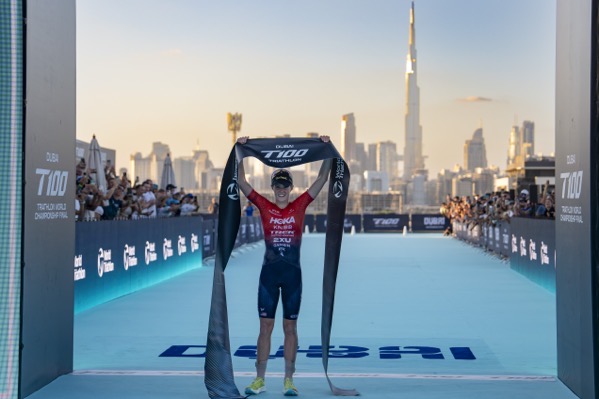
Photo: Taylor Knibb raising the banner after winning Dubai T100 and the T100 Tour, provided by the PTO.
| # |
Name |
Sex |
PTO |
Total |
Share |
| 1 |
Taylor Knibb |
F |
$ 410.000 |
$ 512.300 |
80% |
| 2 |
Marten Van Riel |
M |
$ 401.000 |
$ 410.200 |
98% |
| 3 |
Ashleigh Gentle |
F |
$ 307.500 |
$ 354.427 |
87% |
| 4 |
Kyle Smith |
M |
$ 269.000 |
$ 326.848 |
82% |
| 5 |
Julie Derron |
F |
$ 218.000 |
$ 250.921 |
87% |
| 6 |
Magnus Ditlev |
M |
$ 214.000 |
$ 306.293 |
70% |
| 7 |
Kat Matthews |
F |
$ 186.000 |
$ 549.000 |
34% |
| 8 |
Rico Bogen |
M |
$ 178.500 |
$ 196.303 |
91% |
| 9 |
Sam Long |
M |
$ 167.500 |
$ 207.500 |
81% |
| 10 |
India Lee |
F |
$ 148.500 |
$ 164.876 |
90% |
| 11 |
Laura Philipp |
F |
$ 144.000 |
$ 301.692 |
48% |
| 12 |
Lucy Byram |
F |
$ 136.000 |
$ 146.000 |
93% |
| 13 |
Alistair Brownlee |
M |
$ 132.500 |
$ 132.500 |
100% |
| 14 |
Youri Keulen |
M |
$ 130.000 |
$ 135.000 |
96% |
| 15 |
Imogen Simmonds |
F |
$ 124.500 |
$ 143.500 |
87% |
| 16 |
Flora Duffy |
F |
$ 116.500 |
$ 123.600 |
94% |
| 17 |
Sam Laidlow |
M |
$ 114.000 |
$ 114.000 |
100% |
| 18 |
Mathis Margirier |
M |
$ 113.500 |
$ 123.500 |
92% |
| 19 |
Jelle Geens |
M |
$ 110.000 |
$ 210.250 |
52% |
| 20 |
Paula Findlay |
F |
$ 108.500 |
$ 168.750 |
64% |
| 21 |
Pieter Heemeryck |
M |
$ 107.500 |
$ 107.500 |
100% |
| 22 |
Mika Noodt |
M |
$ 103.000 |
$ 110.500 |
93% |
| 23 |
Frederic Funk |
M |
$ 87.500 |
$ 103.325 |
85% |
| 24 |
Lucy Charles-Barclay |
F |
$ 80.500 |
$ 95.500 |
84% |
| 25 |
Anne Haug |
F |
$ 66.000 |
$ 98.293 |
67% |
Ironman Races
This year’s Ironman money list is topped by the female winner of the Ironman Pro Series, Kat Matthews, who also finished twice in both the Ironman and 70.3 World Championships. She is followed by Patrick Lange (Kona Champion) and Gregory Barnaby (men’s Ironman Pro Series Winner). There have been fewer Ironman Pro events this year, and the number of athletes who have made money from Ironman has also gone down. In 2024 there were 432 different athletes who received a cheque from Ironman.

Photo: Kat Matthews celebrating her second place at 70.3 World Championships in Taupo, allowing her to win the Ironman Pro Series. (Photo by Fiona Goodall/Getty Images for IRONMAN)
| # |
Name |
Sex |
IM |
70.3 |
Pro Series |
Ironman |
Total |
Share |
| 1 |
Kat Matthews |
F |
$ 111.000 |
$ 52.000 |
$ 200.000 |
$ 363.000 |
$ 549.000 |
66% |
| 2 |
Patrick Lange |
M |
$ 145.000 |
|
$ 130.000 |
$ 275.000 |
$ 288.000 |
95% |
| 3 |
Gregory Barnaby |
M |
$ 31.500 |
$ 23.250 |
$ 200.000 |
$ 254.750 |
$ 278.250 |
92% |
| 4 |
Jackie Hering |
F |
$ 51.500 |
$ 9.250 |
$ 130.000 |
$ 190.750 |
$ 210.750 |
91% |
| 5 |
Laura Philipp |
F |
$ 125.000 |
$ 13.500 |
$ 5.000 |
$ 143.500 |
$ 301.692 |
48% |
| 6 |
Lotte Wilms |
F |
$ 39.000 |
$ 7.250 |
$ 85.000 |
$ 131.250 |
$ 144.335 |
91% |
| 7 |
Hannah Berry |
F |
$ 44.500 |
$ 7.500 |
$ 70.000 |
$ 122.000 |
$ 136.161 |
90% |
| 8 |
Kristian Hogenhaug |
M |
$ 25.500 |
$ 3.500 |
$ 85.000 |
$ 114.000 |
$ 133.935 |
85% |
| 9 |
Matthew Marquardt |
M |
$ 23.000 |
$ 3.750 |
$ 70.000 |
$ 96.750 |
$ 106.750 |
91% |
| 10 |
Jelle Geens |
M |
|
$ 87.250 |
$ 5.000 |
$ 92.250 |
$ 212.250 |
43% |
| 11 |
Taylor Knibb |
F |
|
$ 82.500 |
$ 5.000 |
$ 87.500 |
$ 517.300 |
17% |
| 12 |
Matt Hanson |
M |
$ 19.000 |
$ 15.500 |
$ 50.000 |
$ 84.500 |
$ 94.500 |
89% |
| 13 |
Marta Sanchez |
F |
$ 58.000 |
$ 17.250 |
$ 5.000 |
$ 80.250 |
$ 104.347 |
77% |
| 14 |
Maja Stage Nielsen |
F |
$ 26.000 |
$ 2.500 |
$ 50.000 |
$ 78.500 |
$ 86.500 |
91% |
| 15 |
Danielle Lewis |
F |
$ 28.500 |
$ 7.250 |
$ 40.000 |
$ 75.750 |
$ 87.933 |
86% |
| 16 |
Chelsea Sodaro |
F |
$ 60.000 |
$ 3.500 |
$ 5.000 |
$ 68.500 |
$ 95.241 |
72% |
| 17 |
Els Visser |
F |
$ 27.000 |
$ 11.250 |
$ 30.000 |
$ 68.250 |
$ 126.176 |
54% |
| 18 |
Magnus Ditlev |
M |
$ 65.000 |
|
|
$ 65.000 |
$ 306.293 |
21% |
| 19 |
Bradley Weiss |
M |
$ 14.000 |
$ 1.250 |
$ 40.000 |
$ 55.250 |
$ 72.750 |
76% |
| 20 |
Penny Slater |
F |
$ 34.000 |
$ 3.250 |
$ 10.000 |
$ 47.250 |
$ 55.250 |
86% |
| 21 |
Ellie Salthouse |
F |
|
$ 40.750 |
$ 5.000 |
$ 45.750 |
$ 70.750 |
65% |
| 22 |
Hayden Wilde |
M |
|
$ 45.000 |
|
$ 45.000 |
$ 247.575 |
18% |
| 22 |
Rudy von Berg |
M |
$ 45.000 |
|
|
$ 45.000 |
$ 103.234 |
44% |
| 24 |
Lionel Sanders |
M |
$ 24.000 |
$ 15.000 |
$ 5.000 |
$ 44.000 |
$ 55.000 |
80% |
| 24 |
Mathias Petersen |
M |
$ 24.000 |
|
$ 20.000 |
$ 44.000 |
$ 49.000 |
90% |
Challenge
As in previous years, the top money earners on the Challenge side are athletes who focus on the Challenge Family “World Bonus”. This year, Jack Moody was at the top of the Challenge bonus table, making almost all of his money from Challenge events. In total, 220 athletes finished in the money ranks in the 2024 Challenge races. This slight reduction is in line with fewer Pro events under the Challenge banner.

Photo: Jack Moody winning Challenge Quebec, provided by Challenge Family
| # |
Name |
Sex |
Challenge |
Total |
Share |
| 1 |
Jack Moody |
M |
$ 41.145 |
$ 45.306 |
91% |
| 2 |
Alanis Siffert |
F |
$ 39.031 |
$ 68.441 |
57% |
| 3 |
Kyle Smith |
M |
$ 38.848 |
$ 326.848 |
12% |
| 4 |
Els Visser |
F |
$ 31.325 |
$ 126.176 |
25% |
| 5 |
Anne Haug |
F |
$ 29.293 |
$ 98.293 |
30% |
| 6 |
Aurelia Boulanger |
F |
$ 27.919 |
$ 27.919 |
100% |
| 7 |
Ognjen Stojanovic |
M |
$ 27.373 |
$ 34.474 |
79% |
| 8 |
Magnus Ditlev |
M |
$ 27.293 |
$ 306.293 |
9% |
| 9 |
Jesper Svensson |
M |
$ 21.998 |
$ 21.998 |
100% |
| 10 |
Paula Findlay |
F |
$ 20.000 |
$ 168.750 |
12% |
| 11 |
India Lee |
F |
$ 16.376 |
$ 164.876 |
10% |
| 12 |
Frederic Funk |
M |
$ 15.825 |
$ 103.325 |
15% |
| 13 |
Rebecca Robisch |
F |
$ 15.244 |
$ 15.244 |
100% |
| 14 |
Tom Hug |
M |
$ 14.481 |
$ 28.431 |
51% |
| 15 |
Laura Philipp |
F |
$ 14.192 |
$ 301.692 |
5% |
| 15 |
Thomas Bishop |
M |
$ 14.192 |
$ 35.142 |
40% |
| 17 |
Laura Madsen |
F |
$ 13.646 |
$ 78.896 |
17% |
| 18 |
Julie Derron |
F |
$ 11.821 |
$ 253.621 |
5% |
| 19 |
Lucy Byram |
F |
$ 10.000 |
$ 146.000 |
7% |
| 19 |
Marc Dubrick |
M |
$ 10.000 |
$ 54.000 |
19% |
Short Course
As in previous years, the top earner of “short course money” had to be successful in both major events, the World Triathlon Championship Series and SuperTri. This year Cassandre Beaugrand comes out on top of this list, she was able to win both series and didn’t race any longer distances. In total, 166 athletes made money this year in short-course events, up from 115 last year.

Photo: Cassandre Beaugrand standing on top of the podium after the WTC Finals in Torremolinos, provided by World Triathlon.
| # |
Name |
Sex |
WTS |
SuperTri |
Short Course |
Total |
Share |
| 1 |
Cassandre Beaugrand |
F |
$ 138.000 |
$ 81.875 |
$ 219.875 |
$ 219.875 |
100% |
| 2 |
Hayden Wilde |
M |
$ 71.700 |
$ 126.875 |
$ 198.575 |
$ 247.575 |
80% |
| 3 |
Alex Yee |
M |
$ 124.000 |
$ 38.889 |
$ 162.889 |
$ 162.889 |
100% |
| 4 |
Leo Bergere |
M |
$ 81.900 |
$ 77.778 |
$ 159.678 |
$ 195.678 |
82% |
| 5 |
Georgia Taylor-Brown |
F |
$ 26.100 |
$ 126.875 |
$ 152.975 |
$ 164.975 |
93% |
| 6 |
Jeanne Lehair |
F |
$ 38.000 |
$ 77.778 |
$ 115.778 |
$ 115.778 |
100% |
| 7 |
Beth Potter |
F |
$ 90.000 |
$ 13.889 |
$ 103.889 |
$ 103.889 |
100% |
| 8 |
Kate Waugh |
F |
$ 25.800 |
$ 61.875 |
$ 87.675 |
$ 91.675 |
96% |
| 9 |
Vincent Luis |
M |
$ 31.600 |
$ 46.875 |
$ 78.475 |
$ 90.475 |
87% |
| 10 |
Lisa Tertsch |
F |
$ 71.600 |
|
$ 71.600 |
$ 71.600 |
100% |
| 11 |
Matthew Hauser |
M |
$ 42.600 |
$ 27.778 |
$ 70.378 |
$ 70.378 |
100% |
| 12 |
Vetle Bergsvik Thorn |
M |
$ 17.100 |
$ 46.875 |
$ 63.975 |
$ 63.975 |
100% |
| 13 |
Leonie Periault |
F |
$ 35.300 |
$ 27.778 |
$ 63.078 |
$ 63.078 |
100% |
| 14 |
Emma Lombardi |
F |
$ 60.900 |
|
$ 60.900 |
$ 60.900 |
100% |
| 15 |
Tim Hellwig |
M |
$ 2.700 |
$ 56.875 |
$ 59.575 |
$ 60.825 |
98% |
| 16 |
Taylor Spivey |
F |
$ 12.500 |
$ 46.875 |
$ 59.375 |
$ 115.875 |
51% |
| 17 |
Dorian Coninx |
M |
$ 14.600 |
$ 42.778 |
$ 57.378 |
$ 57.378 |
100% |
| 18 |
Max Stapley |
M |
$ 8.300 |
$ 46.875 |
$ 55.175 |
$ 57.675 |
96% |
| 19 |
Barbara De Koning |
F |
$ 1.100 |
$ 46.875 |
$ 47.975 |
$ 47.975 |
100% |
| 20 |
Pierre Le Corre |
M |
$ 44.900 |
|
$ 44.900 |
$ 44.900 |
100% |





